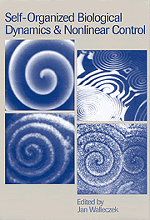 Self-Organized Biological Dynamics and Nonlinear Control
Self-Organized Biological Dynamics and Nonlinear Control Book contents
- Frontmatter
- Contents
- List of contributors
- Preface
- The frontiers and challenges of biodynamics research
- Part I Nonlinear dynamics in biology and response to stimuli
- Part II Nonlinear sensitivity of biological systems to electromagnetic stimuli
- Part III Stochastic noise-induced dynamics and transport in biological systems
- Part IV Nonlinear control of biological and other excitable systems
- Index
Part II - Nonlinear sensitivity of biological systems to electromagnetic stimuli
Published online by Cambridge University Press: 14 August 2009
- Frontmatter
- Contents
- List of contributors
- Preface
- The frontiers and challenges of biodynamics research
- Part I Nonlinear dynamics in biology and response to stimuli
- Part II Nonlinear sensitivity of biological systems to electromagnetic stimuli
- Part III Stochastic noise-induced dynamics and transport in biological systems
- Part IV Nonlinear control of biological and other excitable systems
- Index
Summary
Electromagnetic stimuli represent a special class of external perturbations that are discussed in almost all of the remaining book chapters. Part II therefore provides important information in regard to the biophysical foundations of interactions between biological processes and electric or magnetic fields. In addition, experimental examples are described that demonstrate the nonlinear sensitivity to electromagnetic stimuli of enzymes, single cells and tissues. The principles of electric field interactions and the functional role of bioelectric fields are reviewed in Chapter 6 by Paul Gailey. He discusses the remarkable electrosensitivity of selected biological systems and how oscillating electric fields may be detected and amplified by biological structures. The chapter concludes with the description of a model based on the concept of long-range coherence, which may explain how relatively weak electric fields may effectively interact with excitable cellular assemblies in the presence of noise. An electric field-sensitive cellular oscillator in cells of the immune system is the subject of Chapter 7 by Howard Petty. He discusses experiments that have led to the discovery of coherent metabolic oscillations in human neutrophils, and describes the response of these cells to time-varying chemical and electric fields.
- Type
- Chapter
- Information
- Self-Organized Biological Dynamics and Nonlinear ControlToward Understanding Complexity, Chaos and Emergent Function in Living Systems, pp. 145 - 146Publisher: Cambridge University PressPrint publication year: 2000
